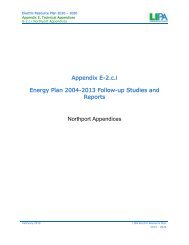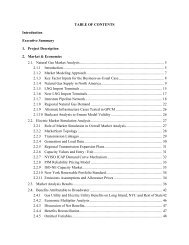Red Book - Long Island Power Authority
Red Book - Long Island Power Authority
Red Book - Long Island Power Authority
You also want an ePaper? Increase the reach of your titles
YUMPU automatically turns print PDFs into web optimized ePapers that Google loves.
2012 Edition <strong>Red</strong>book<br />
Operating<br />
Voltage<br />
120<br />
Table II<br />
Single Phase Air Conditioning<br />
Or Heat Pump Equipment<br />
Capacity<br />
BTU/Hr.<br />
37<br />
Maximum Starting<br />
Current Amp.<br />
240 20,000 or less 60<br />
240 25,000 75<br />
240 30,000 90<br />
240 35,000 105<br />
240 40,000 120<br />
240 In excess of 40,000<br />
50<br />
120<br />
(see note below)<br />
Note:<br />
Motors in these sizes generally require an auxiliary starting device to meet the<br />
starting current limits. The Company should be consulted to obtain allowable inrush<br />
limitations which will vary with service size and location.<br />
9.5 STARTING CURRENT LIMITS FOR THREE PHASE MOTORS<br />
9.5.1 Tables III and IV list the maximum starting current permitted at 240 volts, three<br />
phase for conventional motorized equipment rated in horsepower and for air<br />
conditioning or heat pumping equipment rated in BTU's per hour, on the basis of<br />
not more than four starts per hour.<br />
9.5.2 A customer, upon proper notification to the Company, may connect to the<br />
Company's supply lines, any motor which conforms to the starting current limits<br />
specified in these tables, with or without the use of reduced voltage starting<br />
equipment; provided that the estimated or recorded electrical demand at the point<br />
of service, exclusive of the motor being added, meet the Minimum Demand<br />
Required, shown in the left hand column.<br />
9.5.3 In the case of motor-driven equipment rated greater than 20 HP or 225,000 BTU's<br />
per hour, the Company should be consulted. In cases of motor driven equipment<br />
rated less than 20 HP or 225,000 BTU's per hour, if the equipment in question<br />
cannot meet the starting current limits indicated in the Tables or if the customer's<br />
existing load does not satisfy the minimum demand requirements. The Company<br />
will then determine whether specific conditions at the point of service will permit a<br />
greater starting current to be drawn without adverse effect on the electric service to<br />
other customers.<br />
9.5.4 The starting currents permitted in the Tables are based on motors carrying a<br />
nameplate voltage rating of 220 volts. Motors rated at 200 volts, or at 208 volts, will<br />
actually draw a higher starting current than indicated on their name plates when<br />
they are supplied at a higher voltage, for example, 230 volts. However, for the<br />
purpose of these Rules and Regulations, it may be assumed that the actual<br />
starting currents of motors rated at 200 or 208 volts will be the same as the<br />
starting current (locked rotor current) indicated on the nameplate.






